My Little Pony: Collectible Card Game
Publisher: Enterplay
Format: Card Game
Number of Players: 2
Play Time: 20 Minutes
Yes, you read that right. There is a My Little Pony collectible card game.
Whatever your thoughts on the matter, there's no denying that My Little Pony: Friendship is Magic, and the culture that grew up around it, have become something of a phenomenon. Case in point, I spent this past weekend at Bronycon, held in the Baltimore Convention Center, which saw a record attendance of over 10,000 guests. Unsurprisingly, this CCG was featured there. It is my intent here to set aside any biases - positive or negative - that people have toward this franchise and just examine the game based on its own merits, which are surprisingly many.
This is far from my first CCG. I played Magic: the Gathering and Yu-Gi-Oh for years, and I've dabbled in Kaijudo and Vanguard as well. While I was never terribly competitive about it, I'm no stranger to the card game scene, so I was surprised to find that I had never played one quite like this.
Most CCGs are meant to represent a battle. In Magic, you're a Planeswalker casting spells to defeat your opponent. In Yu-Gi-Oh, you summon an army of monsters to do battle with another summoner. However, that's not what My Little Pony is going for. The show promotes values of friendship and harmony, and in some unusual but very cool ways, the CCG attempts to do the same.
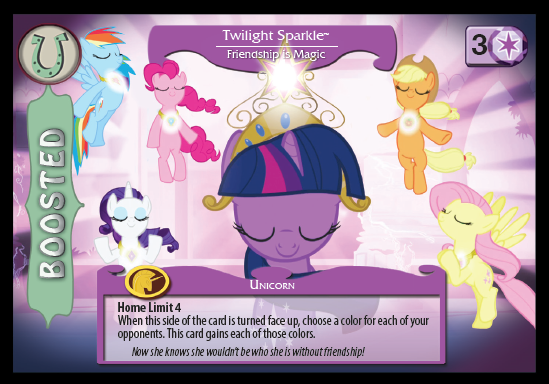
Twilight Sparkle and her friends wield the Elements of Harmony, the most powerful artifacts in the MLP world.Ironically, this is a pretty weak card.
While it is a contest, this game is not a battle with your opponent. Rather, you earn points by confronting various Problem cards, and the first player to reach 15 points wins. Without going too in-depth into the rules of the game, each Problem card may be confronted once per turn, if you have enough power there to do so. Problems are worth one point each time you confront them, and each has a bonus value which is scored twice; Once the first time it's successfully confronted, and again when both players confront it simultaneously, thereby solving it.
That's right, you cannot solve Problems on your own. There are exceptions to this, but they'd be better suited to a rules and strategies discussion than to this article.
The other way this game makes you help your opponent is with its Action Token (AT) system. At the start of each turn, the turn player generates actions tokens, which function a lot like mana does in Magic: the Gathering. You can spend these tokens to play cards, move characters around (more on that later), activate abilities, and do a few other things. Now here's the trick to it: AT generation ramps up as the game progresses, and it's based on the score of the highest scoring player. Aside from being a nice bit of flavor, this helps to keep the game balanced, rather than allowing one player to just take the lead and keep it forever.
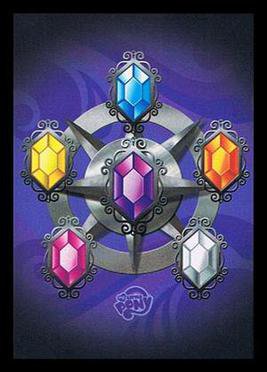
There are six playable colors in the MLP CCG, each representing one of the six Elements of Harmony.
Alright, so the game's based on a popular franchise and it has some cute gimmicks, but is it actually fun to play? Well, yes, or else it wouldn't have merited a Sprites and Dice article. It's got a great concept and a unique style of play not quite like any other game I've encountered. I started playing back at PAX East 2014, and got hooked.
As for how it's played, I've already mentioned that this game is not a fight. There is no way to directly attack your opponent or their Friends. Rather, you have to work somewhat with and somewhat against them as you both attempt to confront Problems and score points.
Each player's deck consists of a minimum of 56 cards: One Mane Character (yes, that's the actual term. Are you finished groaning yet?), a ten card Problem deck, and 45 other cards. These other cards consist of Friends, Events, Resources, and Troublemakers. Friends are other characters, not all of which are friendly. Events cause one-time effects, similar to Instants/Sorceries in Magic, or Spell and Trap cards in Yu-Gi-Oh. Resources remain in play and cause continuous effects, like Enchantments in Magic. Troublemakers aren't quite like anything else; they are used to block Problems from your opponent, forcing them to deal with the Troublemaker before confronting the Problem. The Mane Character is the cornerstone of the deck. It begins the game in play at your Home, which is crucial as many cards require you to have a certain amount of a given color already in play before they can be used. Each Mane Character also has the ability to become stronger and gain new abilities when certain conditions are met. Generally speaking, this one card shapes the remainder of the deck.
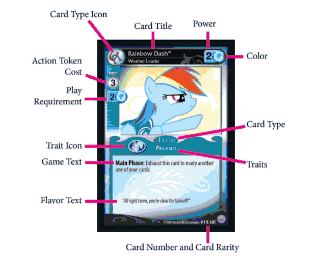
From the official rulebook.It seems like there's a lot to take in here, but the most important parts are the AT Cost, Play Requirement, Power, and Color.
Each player's side of the table is broken up into two zones: Home and Problem. In a typical two-player game this means there are four zones total. Home is, as the name implies, something of a home base for the player. It's where Friends return to once a Problem is solved, and some cards (generally Resources) specify that they remain at Home after being played.
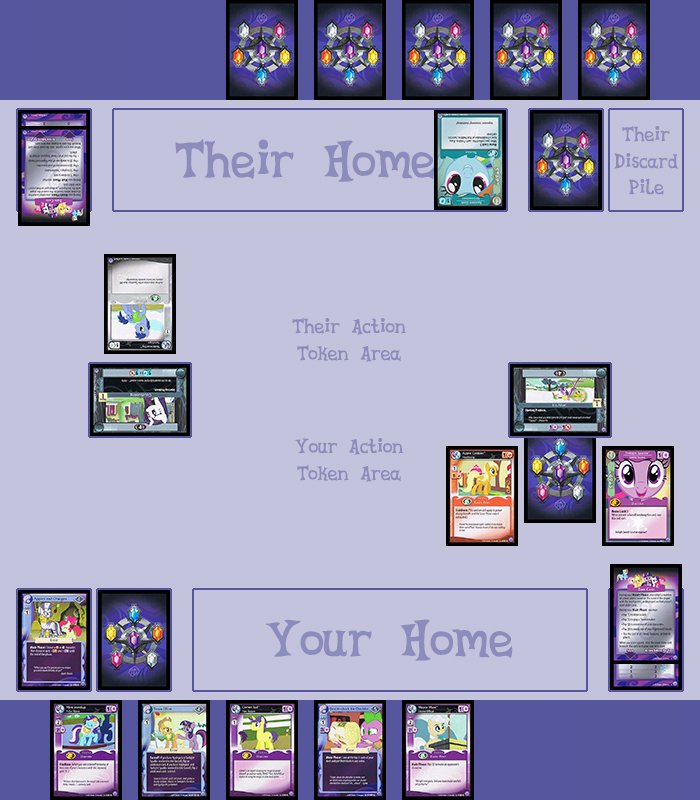
An example of a game in progress. This is the "official" setup.The zones just to the sides of center are the Problems.
The Problem zones are where the action happens. While you cannot play or move your Friends to your opponent's Home, their Problem zone is fair game, as is your own. If you meet the requirements to confront the Problem, you may do so on your turn. If your opponent is also meeting the requirements, this will trigger a face-off.
During a face-off, each player adds up the power of all of their Friends at that Problem, then flips one card from the top of their deck and adds its power to their total. Whoever has the higher total wins and scores the Problem's bonus. It is then considered solved, returned to the bottom of its Problem deck, and a new one is revealed.
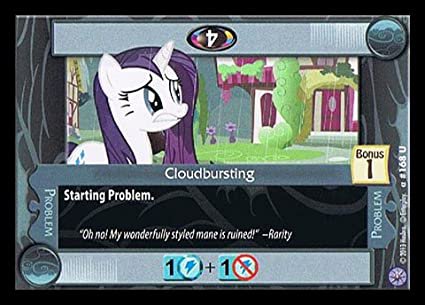
This is an example of a Problem card. Note that there are two different requirements to confront it:The card's owner needs one blue power and one power of any other color. The opponent needs four of any color.
If all of this seems a little overwhelming, don't worry. There's a bit of a learning curve even for experienced CCG players, due to all of the terminology and some of the unusual mechanics, but after a couple of games, it all starts making sense.
So, there you have it: A game based on a cartoon that was meant for little girls, which is quite complex and strategic and surprisingly good. If you enjoy card games, I highly recommend giving this one a try.
This has been part one of a two-part article. In part two I will talk more in depth about my own experience with the game thus far, as well as the current state of the game and the competitive scene.
Like what you've read here? Leave a comment, or visit our Facebook to keep on top of all of our upcoming articles!